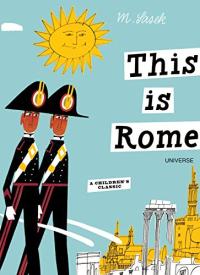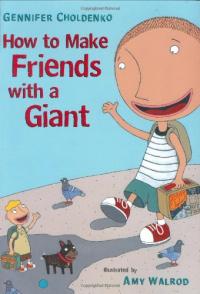
Sweet Dreams (My Family/Mi Familia series)

“Wangari lives under an umbrella of green trees in the shadow of Mount Kenya in Africa.” So begins this tribute to Wangari Maathai, a young woman who saw deforestation turn the lush lands of Kenya into a barren desert. Wangari began to plant seedlings and encouraged the women around her to do the same. By 2004, 30 million trees had been planted and Wangari won the Nobel Peace Prize.
Wangari’s Trees of Peace

By Truck to the North: My Arctic Adventure

This is Rome

Count down with a child who starts with 10 dogs but winds up with only one lovable canine companion. This nursery rhyme is based on a popular Spanish counting ditty which is repetitive and rhythmic, and meant to be sung or recited. Music is included in this cheerily illustrated book.
Ten Little Puppies/Diez perritos

Textured, colorful quilts illuminate a collection of poems all focused on the notion of peace. Some speak to children’s experiences, while others are more sophisticated and abstract. World peacemakers are briefly introduced in illustration for one poem and in back-matter.
Peaceful Pieces: Poems and Quilts about Peace

A short poem made from the word “Lemonade,” is difficult to read with letters dropped from the first word. Turn the page, however, and the poem is easily readable: “made/one/ad/added/one/lemon/load/and/one/mom”. Squeezing a poem out of one word is fun, playful, and downright clever.
Lemonade and Other Poems Squeezed from a Single Word

Celebrate the wonders of books and what they hold in this collection of poems written by well-known children’s poets. Semiabstract illustrations provide an imaginative look at those “…befriended again & again/by a well-loved book./…a wealth/we never lose.”
I Am the Book

“Between 1915 and 1930, more than a million African Americans…moved to the North” including the poet’s family. Join the travelers as they seek a better life in a different part of the United States. Rhythmic but not rhyming verse is complemented by evocative illustrations.
The Great Migration: Journey to the North

Science and poetry combine for an exhilarating look at the night, some of its animals, and other goings-on. Short but sophisticated poems are illustrated with bold line and muted color and accompanied by brief factual information. A glossary of animal terms concludes the collection.
Dark Emperor and Other Poems of the Night

Though first written in the 19th century, Robert Louis Stevenson’s poems still resonate with contemporary readers of all ages. Newly illustrated with a nod to earlier editions, gently hued and highly detailed illustrations add a fresh look to a classic collection.
A Child’s Garden of Verses

Stunning yet accurate illustrations accompany a gently rhyming, rhythmic text to introduce the behavior of a variety of birds. Brief information about the birds shown encourages young readers to want to learn more about these handsome creatures.
Bring on the Birds

While on their outing, baby always responds “moo” when asked by mom and dad what animals say. Slightly older children will see the humor in the predictable pattern and lighthearted illustrations — until baby gets it right when he sees a black and white cow!
Baby Says “Moo”

Poems introduce sea creatures and their habitats using different poetic forms (e.g., concrete, for two voices). Factual information is provided with each poem. This small, attractive collection concludes with where to find out more and a brief explanation of the poetic forms.
At the Sea Floor Cafe: Odd Ocean Critter Poems

Silly poems introduce real animals from around the world. The lively language and accompanying comic illustrations help place animals — from the agoutis to the yak — on a map and concludes with a “menagerie of facts” — sure to delight readers of all ages!
Around the World on Eighty Legs

Cesar Chavez: Fighting for Fairness (Famous Latinos)

“The selfless struggles of labor leader Chavez are given a tempered and lucid treatment in this educational overview… The characters are drawn in an intentionally stiff style that fits with the depth-challenged folk art backgrounds, most of which are dominated by the color of sand. The text, meanwhile, is peppered with quotes from Chavez, all of which are backed up with source notes. An elegant introduction to a man who inspired thousands.”
— Daniel Kraus, Booklist
A Picture Book of Cesar Chavez

Cesar Chavez (On My Own Biography)

Cesar Chavez (Rookie Biographies)

Many years ago in California, an energetic young Girl Scout named Dolores worked to raise money for soldiers fighting in World War II. A thoughtful young boy named Cesar worked in the fields to help his family put food on the table. As young adults, these two extraordinary individuals would meet and spend the rest of their lives working tirelessly on behalf of migrant workers and children through nonviolent struggle — side by side. Monica Brown and Joe Cepeda bring the story of Dolores and Cesar to life through this vibrant bilingual book, which will make an excellent addition to units on migrant farmworkers, civil rights, or women’s history.
Side by Side: The Story of Dolores Huerta and César Chávez/Lado a Lado: La Historia de Dolores Huerta y Cesar Chávez

Read the back story of why — and how — the cow who jumped over the moon (made famous in the nursery rhyme) was able to accomplish this feat. Though no longer in print, this funny parody may be available used or at libraries.
Moonstruck: The True Story of the Cow Who Jumped Over the Moon

Though one is very tall and the other quite short, Jake and Jacomo find they have much in common and find friendship in spite of classmates’ teasing. Though no longer in print, this recognizable, realistic story may be available used or at libraries.
How to Make Friends With a Giant

Shy Lili is so soft spoken she has been marked absent and has a tough time standing up for herself — especially when partnered with bold Cassidy. Lili finds her voice, however, when just in time to help the class pet from disaster. Well told and gently illustrated, all readers are likely to empathize with the well-drawn characters.
Louder, Lili

Tillie Anderson emigrated to the U.S. from Sweden with a sewing needle and a strong sense of what might be. During the 1890s, Tillie trained and became a winning bicycle racer — using her tailoring skills to make more suitable racing outfits! Lighthearted illustrations and informal text tell Tillie’s memorable tale.
